Choosing the right flooring for your stairs has always stirred a mix of practical and aesthetic concerns. Many homeowners wonder: should the stairs match the flooring above or below?
This article covers various scenarios, be it two hardwood floors, mixed flooring options, or even dual carpets.
We'll also touch upon safety considerations and the age-old debate on diversified room flooring.
Whether you're planning a renovation or simply curious, we've got you covered. Keep reading, and let's step into the discussion.
The Stairway Question: To Match The Upstairs or Downstairs Flooring?
Homebuyers often inherit the stairs' flooring design, be it carpet or hardwood, without giving it a second thought.
But, when the redecoration bug bites or there's a desire to revamp your floors, you might suddenly find yourself pondering this pressing question.
Quick Answer
Stairs connect your floors, so they should blend well with both the upper and lower levels. Here's a simple guide:
- Hardwood on both levels? Go for wooden stairs.
- One level with carpet, the other with hardwood? Pick a carpet that goes with the hardwood or wood that complements the carpet.
- Carpet on both levels? Your stairs should be carpeted too.
Keep reading to learn how to mix different floors in rooms, how to use different kinds of wood, and which stairs are the safest.
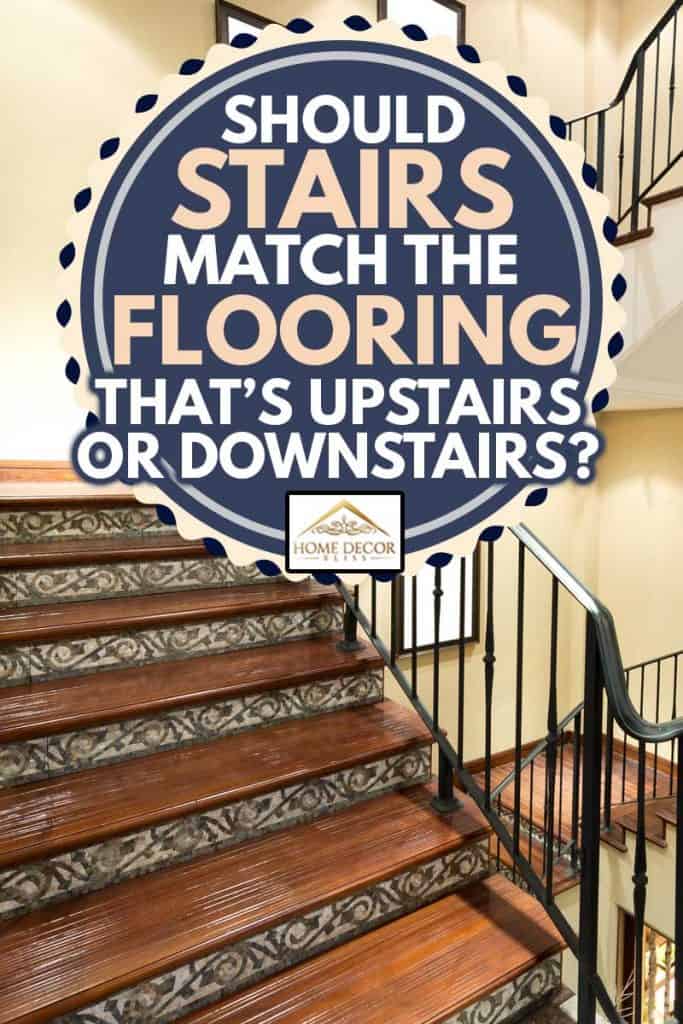
Crafting Cohesive Staircase Flooring
When redesigning your home, stairs are more than just steps. They're a chance to seamlessly connect two different spaces.
Let's dive into making the right choice for your stairway.
Harmonizing Two Hardwood Floors
Hardwood upstairs and downstairs? Great! Go for hardwood stairs. This creates a smooth look.
But if plain hardwood feels too bland, spice it up.
How? Consider a thin runner.
It gives flair without overshadowing the wood. Ensure the stair sides match the overall flooring.
This keeps everything looking just right.
We sometimes add affiliate links and content that was curated and created by our team with the help of advanced ai tools to help showcase the best design styles.
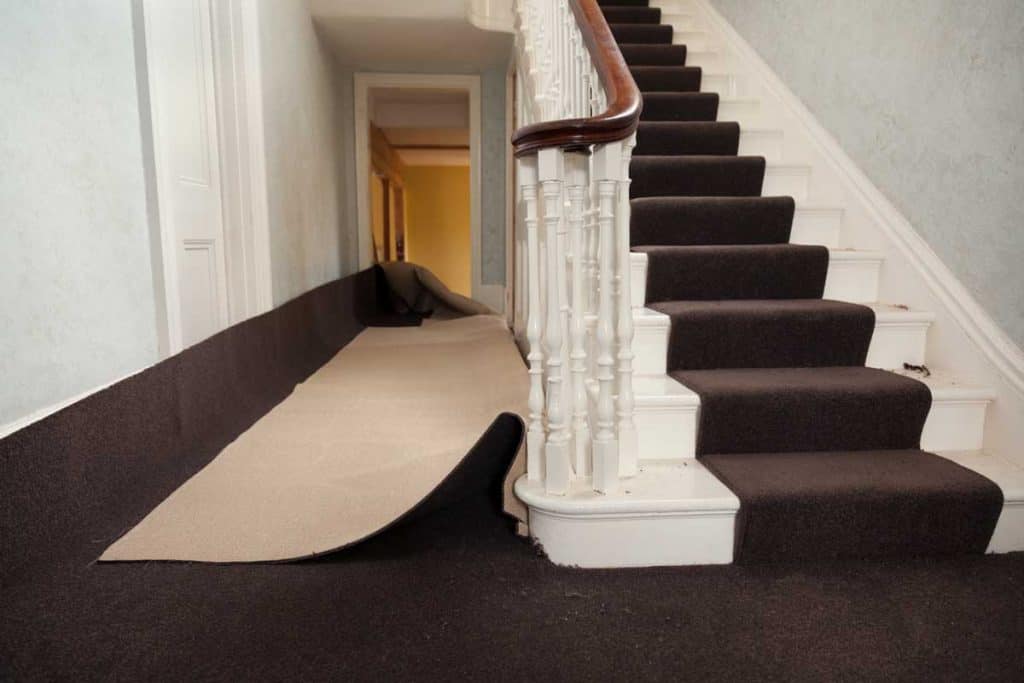
Marrying Mixed Floors
Mixing carpet and hardwood?
It's a bit challenging but fun. Your stairs should bridge the gap between upstairs and downstairs.
Maybe choose a carpet for the stairs that has the same color as the hardwood below.
Or, if you love that wood look, opt for hardwood stairs.
But here's a twist: add a runner that echoes the upstairs carpet. Still unsure?
A trendy approach is to switch it up mid-stairs.
Imagine carpet flowing halfway, and at a landing, it transforms into hardwood.
Just remember, stairs often steal the show, especially downstairs. Ensure they vibe well with the visible flooring.
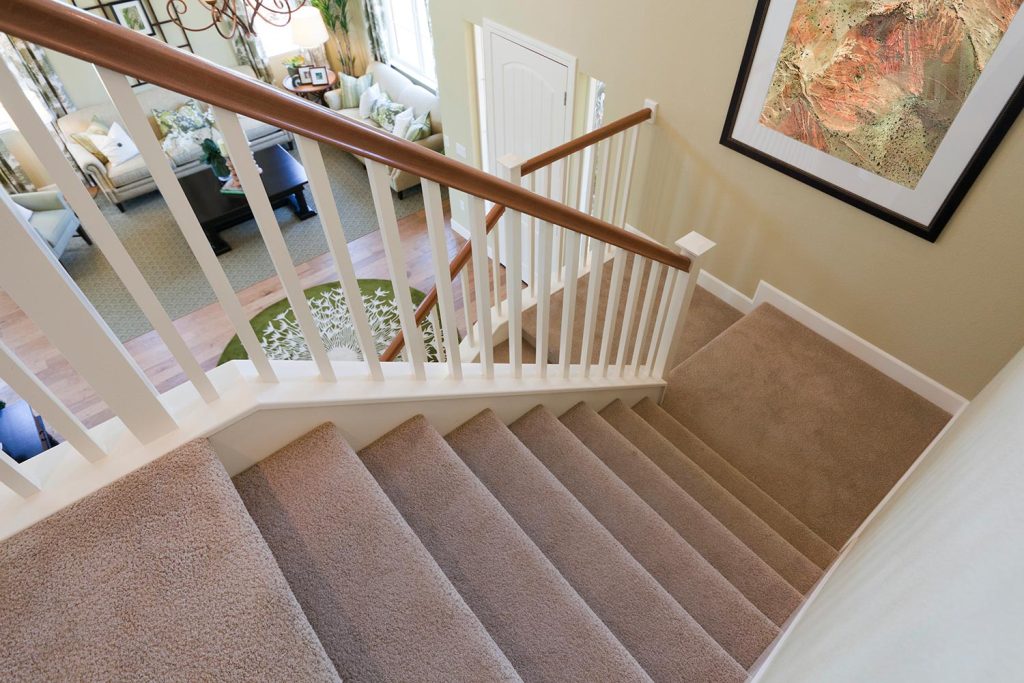
Melding Dual Carpet Styles
Got carpet both up and down? Stick to carpeted stairs. It's a no-brainer.
But what if the carpets don't match?
Here's a tip: look for a stair carpet that captures elements of both.
If choosing gets tough, think about location.
Stairs near the front door catch the eye. Match them with the closest decor and flooring.
This ensures a pleasing view for anyone stepping in.
As you consider the options, always remember: it's about bridging spaces with style and sense.
Ensuring Safe and Stylish Staircase Flooring
Stairs connect the essence of our home, bridging stories and spaces. But beyond aesthetics, ensuring safety is paramount.
Dive into these insights to make informed choices for your staircase.
Safety First: Best Flooring Options for Stairs
Carpet: Soft Touch, Safe Step
Carpet stands out as the top pick for stair safety. The carpet provides traction, offers good grip, and cushions falls.
But remember, not all carpets are made equal.
Pick one with a low pile (3/4 inch or less). It's the best for underfoot grip.
And steer clear of looped carpet styles, especially if you have pets. Their claws can get snagged, causing accidents.
Hardwood: Elegance with Caution
For hardwood enthusiasts, you're not out of options. With the right tweaks, hardwood stairs can be safe.
Always have hand railings. Boost grip by adding clear non-slip treads.

Click Here To See These Non-Slip Stair Treads On Amazon
Tile: Durable and Versatile
Tiles are not only for kitchens and bathrooms. They offer a durable solution for stairs and come in an array of designs and finishes.
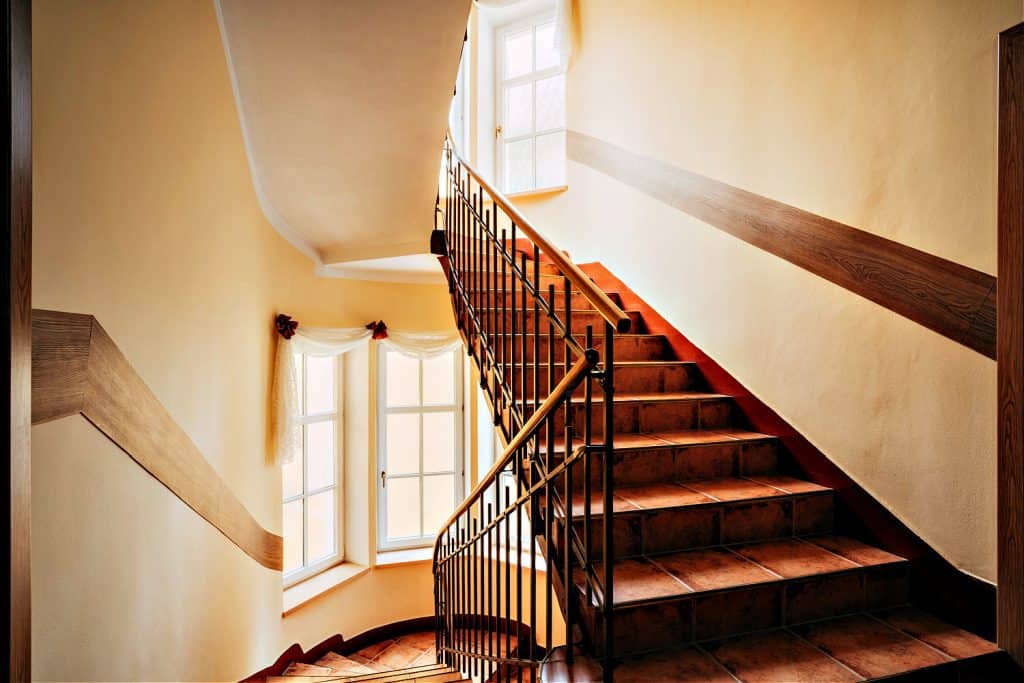
Slip-resistant tiles, often with textured surfaces, are ideal for staircases.
They’re easy to clean and can mimic the look of other materials, offering flexibility in design.
Comparison of Stair Flooring Options
| Flooring Option | Pros | Cons |
|---|---|---|
| Hardwood | - Aesthetically pleasing - Durable - High resale value - Easy to clean | - Can be slippery - Higher cost - Requires maintenance - Noisy |
| Carpet | - Safer due to traction - Warm and cozy - Noise reduction - Variety in design | - Maintenance required - Less durable - Potential allergen trap |
| Tile | - Durable - Easy maintenance - Design variety - Moisture resistant | - Hard and unforgiving - Feels cold - Complex installation |
| Blend (Hard Floor With Carpet Runner) | - Versatile design - Enhanced safety - Highly customizable | - Dual maintenance - Potentially costly - More complex installation |
Decor Styles: Matching vs. Coordinated
Is It Okay To Have Different Flooring In Different Rooms?
Flooring choices usually fall into two categories:
Category 1: Matched Flooring
It's all about precision. Every floor mirrors the other. This style is exact and precise - the floors are the same, not "nearly" the same or "close" to the same.
In this approach, you'll limit yourself to 1-3 flooring types throughout the home.
Category 2: Coordinated Flooring
The other style is called coordinated. Floors that are coordinated but not matching can give a more relaxed and less formal vibe to your decor.
It also gives you more freedom in selecting your floors. In this style, you repeat similar flooring elements throughout the house to give an overall sense of unity.
Maybe your living room sports a hardwood floor, and your kitchen has a similarly colored tile. This style champions variation, but with a theme.
Overall, these elements work together because they have common features, even though nothing matches.
In this coordinated style, it's welcome and encouraged to have different flooring in different rooms. The function of each room can also be given more consideration when picking flooring.
For a seamless transition, especially between different floor types like hardwood and tile, consider using thresholds or moldings at natural transition points.
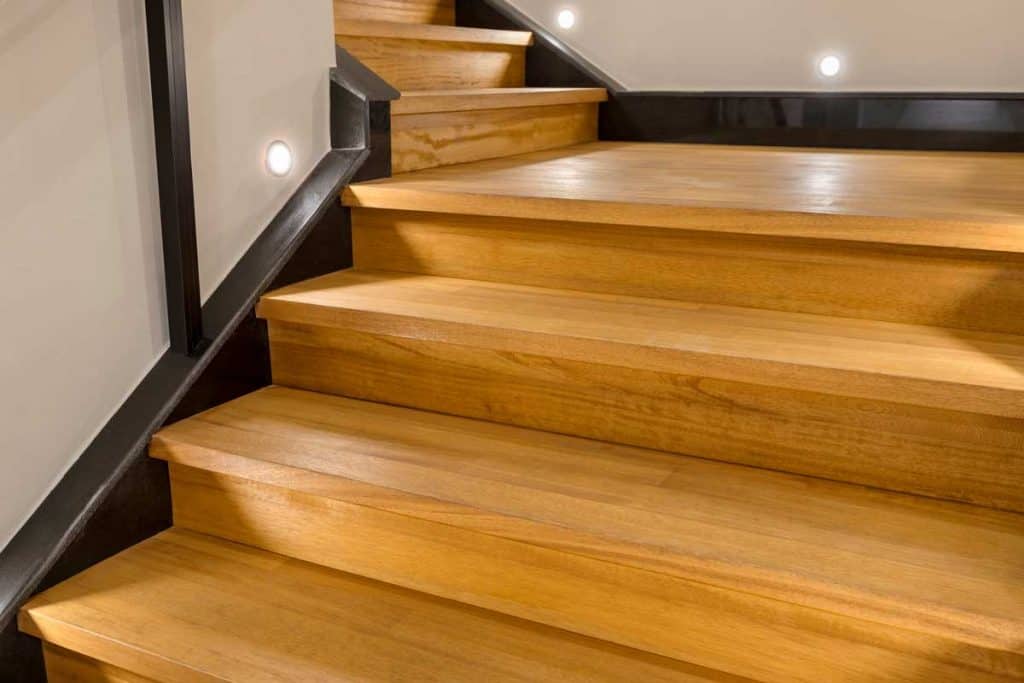
Playing With Colors: Wood Floor Edition
Can you have two different colored wood floors?
Love wood but want variety?
Dive into coordinating colors. But be wary. Too similar yet different colors can feel off. To nail this:
- Bright, glossy woods? Best for small rooms.
- Select warm wood colors for large, dimly lit spaces.
- The transition between rooms or areas should occur at natural points in straight lines. You can use molding to make a distinct transition line between floors.
- Pick contrasting woods so that they stand out as being clearly different from each other. Don't try to blend them, as the subtle differences between the two kinds of wood stand out more that way.
For stairs, you may be able to blend two different colored floors by simply using both colors together. For example, you can use one color on the riser and one on the tread.
Another option is to use one color on the stairs and one as an accent for the handrail. Or you can use planks that vary in color.
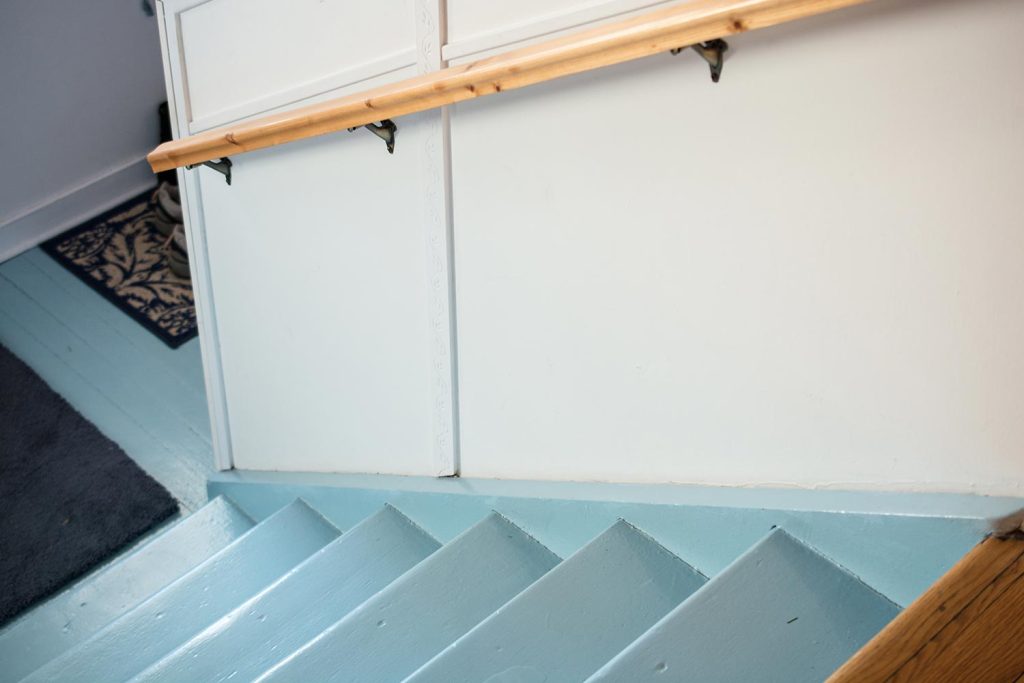
DIY Tips: Staining or Painting Plywood Stairs
Can you paint or stain plywood stairs?
Yes, you can! It's a manageable DIY project.
If painting, prep, prime, and seal.
Painting stairs requires prep work, a coat of primer, paint, and then sealing with water-based polyurethane.
Staining? Sand, condition, stain, then seal.
To stain stairs instead, you'll still have to prep the stairs before beginning.
Next, you will apply a wood conditioner and then the stain. Finally, the last step is to seal with water-based polyurethane, just like when painting.
For specific project instructions, please see How to Paint or Stain Plywood Stairs? [4 Steps]
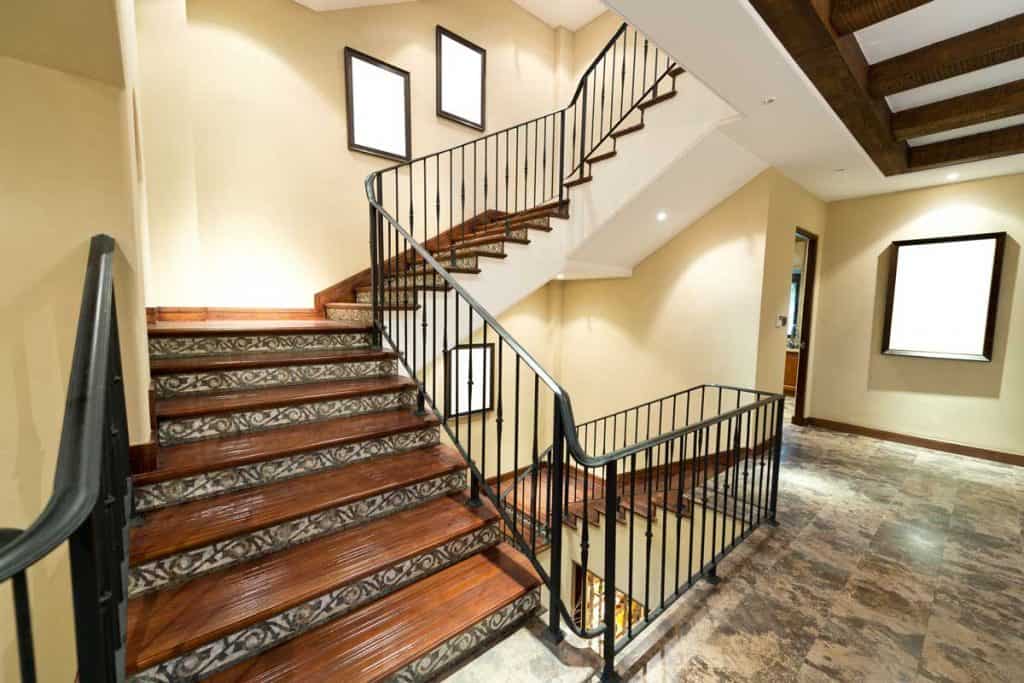
FAQs on Staircase Flooring: Making Every Step Count
1. How often should I replace stair carpeting?
Typically, stair carpeting should be replaced every 5 to 7 years, but this can vary depending on foot traffic and maintenance. If you notice signs of wear, tear, or fraying, it might be time for a change.
2. How can I ensure my hardwood stairs aren’t slippery?
- To prevent hardwood stairs from becoming slippery, you can:
- Apply anti-slip adhesive stair treads.
- Use non-slip mats or rugs.
- Regularly clean the stairs to remove any dust or debris.
- Consider using a slip-resistant finish when treating the wood.
3. Can I mix and match different flooring styles without affecting my home's resale value?
Yes, you can! In fact, well-coordinated flooring can enhance the aesthetic appeal of your home. However, it's essential to ensure that the transitions are seamless and that the styles don't clash.
Potential homebuyers often look for a harmonious flow in a house. If done right, mixing and matching can add character and even boost resale value.
4. Is tile a good choice for staircase flooring?
Tile can be a stylish choice for stairs, especially in homes with a Mediterranean or contemporary aesthetic.
However, ensure the tiles have a slip-resistant finish and are durable enough to handle foot traffic.
5. What’s the best way to maintain hardwood staircase flooring?
For hardwood staircases:
- Regularly sweep or vacuum to remove debris.
- Clean using a damp mop and a cleaner specifically designed for hardwood.
- Refrain from using excessive water or harsh chemicals.
- Consider resealing the wood every few years to protect against wear and maintain its shine.
We hope these answers guide you in making the right choices for your staircase.
The Art Of Staircase Flooring
Staircases bridge your home's stories.
Their flooring, be it wood, carpet, or tile, should seamlessly meld the upstairs and downstairs tales.
So, what story will your stairs tell?
Stairs are a transition between the first and second floors of a home.
For this reason, the flooring for stairs should also be a transition that blends both the upstairs and downstairs floors.
Some possible selections include wood stairs, carpeted stairs, or combining elements from both by using wood stairs and a runner.
If you enjoyed this article, try:
